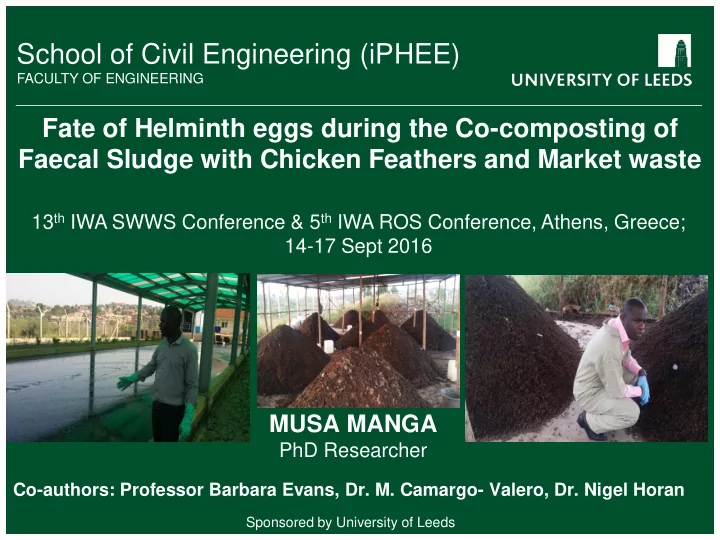

School of Civil Engineering (iPHEE) School of Civil Engineering (iPHEE) FACULTY OF ENGINEERING FACULTY OF ENGINEERING Fate of Helminth eggs during the Co-composting of Faecal Sludge with Chicken Feathers and Market waste 13 th IWA SWWS Conference & 5 th IWA ROS Conference, Athens, Greece; 14-17 Sept 2016 MUSA MANGA PhD Researcher Co-authors: Professor Barbara Evans, Dr. M. Camargo- Valero, Dr. Nigel Horan Sponsored by University of Leeds
School of Civil Engineering (iPHEE) FACULTY OF ENGINEERING Presentation Outline 1. Introduction 2. Methodology 3. Results and Discussion 4. Conclusions 5. Acknowledgements
School of Civil Engineering (iPHEE) FACULTY OF ENGINEERING Introduction • Sanitation service delivery has not been harmonised with the needs of the increasing population. • Sustainable FS treatment technologies are largely still lacking in urban Africa. So where do the diverted FS trunks that don’t reach Bugolobi treatment plant dispose of ????
School of Civil Engineering (iPHEE) FACULTY OF ENGINEERING Introduction Cont’d Source: SuSanAforum • Proper and sustainable treatment is required to inactivate pathogens if FS is reused in agriculture
School of Civil Engineering (iPHEE) FACULTY OF ENGINEERING Introduction Cont’d • Composting has been proven to be a economically and technically feasible FS treatment technology with recovery of nutrients as added value. • However, it is associated with both insufficient pathogen inactivation and longer inactivation periods (especially helminth eggs) • Helminth eggs (esp. Ascaris eggs) are the best pathogenic indicators. • Moreover, little is known about the fate of viable helminth eggs during composting of FS. • This study assessed the effect of locally available organic waste types and their mixing ratios with FS on viable helminth eggs inactivation efficiency.
School of Civil Engineering (iPHEE) FACULTY OF ENGINEERING Methodology: Field trials _Composting facility Constructed Compost facility
School of Civil Engineering (iPHEE) FACULTY OF ENGINEERING Methodology Cont’d: Collection of waste materials
School of Civil Engineering (iPHEE) FACULTY OF ENGINEERING Methodology Cont’d: Collection of waste materials
School of Civil Engineering (iPHEE) FACULTY OF ENGINEERING Methodology Cont’d: Collection of waste materials
School of Civil Engineering (iPHEE) FACULTY OF ENGINEERING Methodology Cont’d: Setting-up of Composting piles • SOS1 : S ludge: O rganic market waste: S awdust (1:2:1) • SOS2 : S ludge: O rganic market waste: S awdust (1:3:1) • SCS1 : S ludge: C hicken feather: S awdust (1:2:1) • SCS2 : S ludge: C hicken feather: S awdust (1:3:1)
School of Civil Engineering (iPHEE) FACULTY OF ENGINEERING Methodology Cont’d: Monitoring of composting piles • Pile temperature: Top, middle, bottom and outer layers • Pile aeration: -Manual Turning • Moisture Content: 50 - 60%
School of Civil Engineering (iPHEE) FACULTY OF ENGINEERING Methodology Cont’d: Monitoring of composting piles • Analytical methods Total Solids- (USEPA 2003) Helminth eggs- (USEPA 2003) • Statistical Analysis Friedman test, with 95% confidence level. Spearman’s rho test
School of Civil Engineering (iPHEE) FACULTY OF ENGINEERING Results and Discussion: Composting Temperatures Pile 1_SOS1 Pile 1_SOS2 32 days 70 70 39 days Pile 2_SOS2 Pile 2_SOS1 Ambient Ambient 60 60 0 C) 0 C) Temperature ( Temperature ( 50 50 40 40 30 30 20 20 0 14 28 42 56 70 84 0 14 28 42 56 70 84 Composting Period (Days) Composting Period (Days) Pile1_SCS2 Pile 1_SCS1 46 days 39 days 70 70 Pile 2_SCS2 Pile 2_SCS1 Ambient Ambient 60 60 0 C) 0 C) Temperature ( Temperature ( 50 50 40 40 30 30 20 20 0 14 28 42 56 70 84 0 14 28 42 56 70 84 Composting Period (Days) Composting Period (Days)
School of Civil Engineering (iPHEE) FACULTY OF ENGINEERING Results and Discussion: Pathogen Inactivation Viable Ascaris Eggs Die-off (% of Initial Viable Count) SOS1 100 SOS2 SCS1 SCS2 80 • 60 Mixing ratios had little effect of helminth eggs inactivation SCS1 & SCS2 40 periods 20 SOS1 & SOS2 0 0 14 28 42 56 70 Composting Period (days) • Chicken feathers piles exhibiting a higher inactivation efficiency and shorter inactivation period than market waste piles. • Composting of FS with chicken feathers reduces the helminth eggs inactivation period from 8 weeks to about 4-6 weeks, which represents approximately 42% reduction in the inactivation periods.
School of Civil Engineering (iPHEE) FACULTY OF ENGINEERING Results and Discussion: Temperature-Time Relationship Vs Helminth Inactivation SOS1 & SOS2 SCS1 & SCS2 Viable Ascaris Eggs Inactivated (%) • All the composting piles met the USEPA 100 (2003) criteria for pathogen inactivation. SOS1 80 SOS2 SCS1 SCS2 60 • Helminth eggs inactivation efficiency was Ambient significantly different. 40 20 • Other mechanisms could have been 0 responsible for pathogen inactivation during 70 ≥55 0 C for ≥21 days 0 C) composting such as 60 Mean Temperature ( antibiotic action induced by indigenous 50 microorganisms 40 antagonistic effect between organisms 30 Toxic by-products (such as NH 3 ) 20 0 14 28 42 56 70 84 Composting Period (Days)
School of Civil Engineering (iPHEE) FACULTY OF ENGINEERING Conclusions • The mixing ratios had little effect onto the pathogen inactivation efficiency, but 1:2:1 preferred to 1:3:1. • Compost piles containing chicken feathers achieved the shortest pathogen survival period of 4 weeks compared to 6-8 weeks for market waste piles. • Apart from the temperature-time relationship, other mechanisms were responsible for enhancing pathogen inactivation efficiency within the chicken feathers composting piles. • All the composting piles attained 100% pathogen inactivation from faecal sludge • Composting of faecal sludge with chicken feather can reduce pathogen inactivation periods by 42%, which may thus reduce the operational costs of faecal sludge treatment facility.
School of Civil Engineering (iPHEE) FACULTY OF ENGINEERING Acknowledgements • Funder: University of Leeds through the Leeds International Research Scholarship. • Supervisors: Prof. Barbara Evans, Dr. Miller & Dr. Horan. • National Water and Sewerage Corporation staff at the Bugolobi and Lubigi FS treatment facility
School of Civil Engineering (iPHEE) FACULTY OF ENGINEERING THANK YOU!!!
Recommend
More recommend